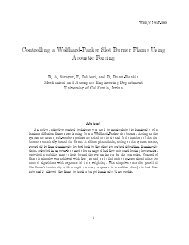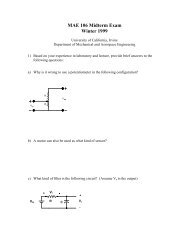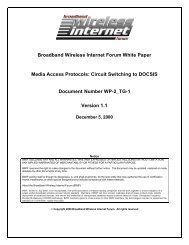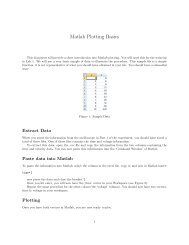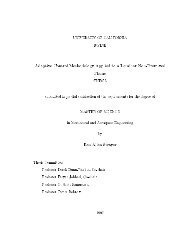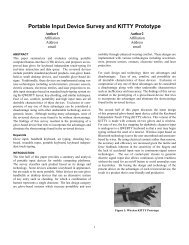Supplementary Handout for ME 147 Mechanical Vibrations Fall ...
Supplementary Handout for ME 147 Mechanical Vibrations Fall ...
Supplementary Handout for ME 147 Mechanical Vibrations Fall ...
Create successful ePaper yourself
Turn your PDF publications into a flip-book with our unique Google optimized e-Paper software.
<strong>Supplementary</strong> <strong>Handout</strong> <strong>for</strong> <strong>ME</strong> <strong>147</strong><br />
<strong>Mechanical</strong> <strong>Vibrations</strong><br />
<strong>Fall</strong> 2001<br />
Instructor: Faryar Jabbari<br />
Department of <strong>Mechanical</strong> Engineering<br />
University of Cali<strong>for</strong>nia, Irvine<br />
0–1
1 Preliminaries and Background Material<br />
Imaginary<br />
P<br />
b<br />
A<br />
O<br />
θ<br />
a<br />
Figure 1: A vector in the complex plane<br />
Real<br />
1.1 Complex Numbers, Polar coordinates<br />
Recall that we define<br />
i = √ −1 (sometimes we use ‘j ′ !) (1.1)<br />
Now in the diagram above, consider point ‘P’ in the complex plane. We denote the<br />
length OP = A, where clearly,<br />
a = Acosθ, b = Asinθ (1.2)<br />
We can use one of the following coordinates<br />
Cartesian Coordinates : P = a + ib (1.3)<br />
P olar Coordinate : P = Ae iθ (1.4)<br />
1–2
Equations (1.2)-(1.4) imply e iθ = cosθ +jsinθ, which is the same as the Euler’s’ identity<br />
further below. We can use these equations to do basic operations on complex numbers<br />
Addition: let<br />
X 1 = A 1 e iwt , X 2 = A 2 e i(wt+φ)<br />
where φ is the phase angle between the X 1 and X 2 .Then<br />
X 1 + X 2 =(A 1 + A 2 e iφ )e iwt =[(A 1 + A 2 cosφ)+iA 2 sinφ]e iwt = A 3 e i(wt+α)<br />
where<br />
A 2 3 =(A 1 + A 2 cosφ) 2 +(A 2 sinφ) 2<br />
and<br />
tanα =<br />
A 2 sinφ<br />
A 1 + A 2 cosφ<br />
Multiplication: let<br />
X 1 = A 1 e iθ 1<br />
, X 2 = A 2 e iθ 2<br />
then<br />
X 1 X 2 = A 1 A 2 e i(θ 1+θ 2 )<br />
Why Can you show it<br />
Square root, etc.: From multiplication, we know that<br />
(Ae iθ )(Ae iθ )=A 2 e i2θ<br />
there<strong>for</strong>e, we can write<br />
(Ae iθ ) n = A n e inθ<br />
where n can be any real number (and not necessarily an integer). For example,<br />
(Ae iθ ) 1 2 = A 1 2 e i θ 2<br />
1–3
or more generally<br />
(Ae iθ ) 1 n = A<br />
1<br />
n e<br />
i θ n<br />
Derivatives: Now suppose that θ was changing with a constant rate of change, i.e., θ = wt<br />
<strong>for</strong> some w, and point P , as a result, is rotating counter clockwise.<br />
Then vector P is<br />
changing with time, there<strong>for</strong>e, it has time derivative (or velocity!), i.e.,<br />
P = Ae iwt (1.5)<br />
Ṗ = iwAe iwt = iwP (1.6)<br />
¨P = −w 2 Ae iwt = −w 2 P (1.7)<br />
Finally, think about taking derivative of ‘a ′ in (1.2). We can write<br />
ȧ = −wAsinθ, ä = −w 2 cosθ (1.8)<br />
or we can use the following<br />
a = Real(P )=Real(Ae iwt )<br />
and there<strong>for</strong>e,<br />
and similarly<br />
ȧ = Real(Ṗ )=Real(iwP )=−wAsinθ (1.9)<br />
ä = Real( ¨P )=Real(−w 2 P )=−w 2 Acosθ (1.10)<br />
We will see in future chapters that this trick can save a great deal of time.<br />
1–4
1.2 Power Series, etc<br />
1.3 Euler’s Identity, . . .<br />
e x =<br />
∞∑<br />
k=0<br />
cos θ =1− θ2<br />
2! + θ4<br />
4!<br />
sin θ = θ − θ3<br />
3! + θ5<br />
5!<br />
x k<br />
k!<br />
(1.11)<br />
<strong>for</strong> θ real (1.12)<br />
<strong>for</strong> θ real (1.13)<br />
e iθ =cosθ + i sin θ (1.14)<br />
e −iθ =cosθ − i sin θ (1.15)<br />
cos θ = eiθ + e −iθ<br />
2<br />
(1.16)<br />
sin θ = eiθ − e −iθ<br />
= −i(eiθ − e −iθ )<br />
2i<br />
2<br />
(1.17)<br />
1.4 Trigonometric Identities<br />
(A + B) (A − B)<br />
sin A +sinB =2sin cos<br />
2 2<br />
(1.18)<br />
(A + B) (A − B)<br />
cos A +cosB =2cos cos<br />
2 2<br />
(1.19)<br />
sin(A + B) =sinA cos B +sinB cos A (1.20)<br />
cos(A + B) =cosA cos B − sin A sin B (1.21)<br />
sin A sin B = 1 [− cos(A + B)+cos(A − B)]<br />
2<br />
(1.22)<br />
cos A cos B = 1 [cos(A + B)+cos(A − B)]<br />
2<br />
(1.23)<br />
sin A cos B = 1 [sin(A + B)+sin(A − B)]<br />
2<br />
(1.24)<br />
1–5
1.5 Orthogonality Conditions <strong>for</strong> Fourier Series<br />
Let w = 2π<br />
τ<br />
, where τ is in seconds (i.e., period of motion), then <strong>for</strong> all positive integers n<br />
and m following identities hold:<br />
∫ τ/2<br />
−τ/2<br />
∫ τ/2<br />
−τ/2<br />
∫ τ/2<br />
−τ/2<br />
∫ π<br />
{<br />
0 if m ≠ n<br />
cos nwt cos mwt dt = τ<br />
2<br />
if m = n<br />
{<br />
0 if m ≠ n<br />
sin nwt sin mwt dt = τ<br />
2<br />
if m = n<br />
{<br />
0 if m ≠ n<br />
cos nwt sin mwt dt =<br />
0 if m = n<br />
{<br />
e inx e −imx 0 if m ≠ n<br />
dx =<br />
2π if m = n<br />
−π<br />
(1.25)<br />
(1.26)<br />
(1.27)<br />
(1.28)<br />
1–6
2 Fourier Series<br />
Consider a periodic function x(t) withaperiodofτ ; i.e.,<br />
We define the following :<br />
x(t) =x(t + τ) =x(t +2τ) =.... <strong>for</strong> all t.<br />
w 1 = 2π<br />
τ<br />
fundamental frquency or ‘harmonic ′<br />
w n = nw 1 , n =2, 3, 4,... higher harmonics<br />
The basic idea is that the periodic function, x(t), can be represented by a, possibly<br />
infinite, sum of its harmonics (i.e., its ‘Fourier Series Representation’):<br />
x(t) = a o<br />
2<br />
+ a 1 cos w 1 t + a 2 cos w 2 t + a 3 cos w 3 t + ··· (2.1)<br />
+ b 1 sin w 1 t + b 2 sin w 2 t + b 3 sin w 3 t + ··· (2.2)<br />
Finding a i ’s and b i ’s (which are called the Fourier coefficients) is relatively simple. For<br />
example, multiply (2.1) by cosw n t, integrate both sides and use the orthogonality conditions<br />
(from the previous section) to get the following<br />
a n = 2 τ<br />
∫ τ<br />
2<br />
− τ 2<br />
x(t) cos w n tdt ,w n = nw 1 , n =1, 2, 3,... (2.3)<br />
b n = 2 τ<br />
∫ τ<br />
2<br />
− τ 2<br />
x(t) sin w n tdt ,w n = nw 1 , n =1, 2, 3,... (2.4)<br />
a o = 2 τ<br />
∫ τ<br />
2<br />
− τ 2<br />
x(t)dt i.e., the average<br />
2–1
Next, recall that<br />
AcosX + BsinX = √ A 2 + B 2 cos (X − φ) (2.5)<br />
= √ A 2 + B 2 sin (X − φ)<br />
where<br />
tan φ = B A<br />
There<strong>for</strong>e, we can rewrite the Fourier series representation as<br />
x(t) = a o<br />
2 + ∞ ∑<br />
2.1 Complex Representation<br />
n=1<br />
c n = √ A 2 + B 2 , tan φ = b n<br />
a n<br />
c n cos(w n t − φ n ), (2.6)<br />
We can also use Euler’s identity to provide another <strong>for</strong>m of the Fourier series. Using the<br />
(complex) exponential <strong>for</strong>m of cos and sin (e.g., cos x = eix +e −ix<br />
2<br />
), we can rewrite (2.1) as<br />
x(t) = a o<br />
2 + ∞ ∑<br />
n=1<br />
= a o<br />
2 + ∞ ∑<br />
n=1<br />
recalling w n = nw 1 ,wecanwrite<br />
x(t) =<br />
∞∑<br />
n=−∞<br />
c n e inw 1t<br />
[ a n<br />
e iwnt + e −iwnt<br />
2<br />
e iwnt ( a n<br />
2 + b n<br />
2i ) + ∞ ∑<br />
, where<br />
⎧<br />
⎪⎨<br />
⎪⎩<br />
+ b n<br />
e iwnt − e −iwnt<br />
2i<br />
n=1<br />
e −iwnt ( a n<br />
2 − b n<br />
2i )<br />
c o = ao<br />
2<br />
c n = an−ibn<br />
2<br />
, n > 0<br />
c n = an+ibn<br />
2<br />
, n < 0<br />
We can simplify a bit more. For example, consider the expression <strong>for</strong> c n <strong>for</strong> n>0: using<br />
the definitions of a n and b n from (2.3) and (2.4), respectively, we get<br />
]<br />
c n = 1 2 (a n − ib n )= 1 2 { 2 τ<br />
∫ τ<br />
2<br />
− τ 2<br />
(x(t)cosnw 1 n − ix(t)sinnw 1 t) dt }<br />
2–2
or<br />
c n = 1 τ<br />
∫ τ<br />
2<br />
x(t)(cos nw 1 n − i sin nw 1 t) dt = 1 τ<br />
∫ τ<br />
2<br />
x(t)e −inwnt dt<br />
− τ 2<br />
− τ 2<br />
Similarly, <strong>for</strong> n
3 Notes <strong>for</strong> Chapter 3<br />
3.1 Frequency Response<br />
Consider the differential equation,<br />
mẍ + cẋ + kx = F (t) =F o cos wt. (3.1)<br />
After taking the Laplace trans<strong>for</strong>m, we get<br />
x(s) =<br />
msx(0) + mẋ(0) + cx(0)<br />
ms 2 + cs + k<br />
+<br />
F (s)<br />
ms 2 + cs + k = x 1(s)+x 2 (s) (3.2)<br />
where F (s) is the Laplace trans<strong>for</strong>m of F (t), i.e.,<br />
F (s) =<br />
With these, we make the following definition<br />
Definition: Set x(0) = ẋ(0) = 0.<br />
F os<br />
s 2 + w 2<br />
Transfer Function △ = H(s) = x(s)<br />
F (s) = 1<br />
ms 2 + cs + k<br />
(3.3)<br />
i.e., the transfer function is the ratio of the output (i.e., x) to the input (i.e., F )inthe<br />
s-domain, setting all initial condition to zero. Now, going back to (3.2), and taking inverse<br />
Laplace, we have<br />
x(t) =x 1 (t)+x 2 (t).<br />
Consider the first term. From the results of chapter 2, we know that<br />
x 1 (t) =e −ζwnt (X 1 cosw d t + X 2 sinw d t)<br />
√<br />
where X 1 and X 2 depend on the initial conditions and w d = w n 1 − ζ 2 . Aslongaswe<br />
have some damping, the exponential terms decays to zero; i.e., x 1 (t) → 0ast →∞. As a<br />
result,<br />
x steadtstate (t) =x ss (t) =x 2 (t).<br />
3–1
From now on, let us focus on this steady state solutions (i.e., we either have no initial<br />
conditions or we assume that the transients die out fast and we need to study long term<br />
behavior). We will try the odd ‘partial fraction expansion’ method<br />
x 2 (s) =H(s) F (s) =<br />
1<br />
ms 2 + cs + k<br />
F o s<br />
s 2 + w 2 = As + B<br />
s 2 + w 2 +<br />
Ds + C<br />
ms 2 + cs + k<br />
(3.4)<br />
Ds+C<br />
where A, B, C and D are to be found. Now the last term (i.e.,<br />
ms 2 +cs+k<br />
) results (after<br />
inverse Laplace trans<strong>for</strong>m) in terms like e −ζwnt (....), just as in x 1 (t), which goes to zero as<br />
time goes to infinity. There<strong>for</strong>e, <strong>for</strong> the steady state response, we can concentrate on the<br />
term As+B<br />
s 2 +w 2 . For this, multiply (3.4) by s 2 + w 2 to get<br />
H(s)F o s =(As + B)+H(s)(Ds + c)(s 2 + w 2 ). (3.5)<br />
This equation is true <strong>for</strong> all values of s. In particular, we can use two specific values<br />
that let the last term disappear; i.e, s = ±iw! toget<br />
H(iw)F o iw = Awi + B (3.6)<br />
−H(−iw)F o iw = −Awi + B (3.7)<br />
Solving these two equations (by adding and subtracting them from each other) yields<br />
{<br />
B =<br />
1<br />
2 F owi [H(iw) − H(−iw)]<br />
A = 1 2 F o [H(iw)+H(−iw)]<br />
(3.8)<br />
Since the rest of the coefficients of H(s) are real, we have H(−iw) =H(iw) which<br />
results in<br />
{<br />
A = Fo Real[H(iw)]<br />
B = −F o wImag[H(iw)]<br />
As a result, using (3.8) in (3.4), after a little bit of work, we have<br />
(3.9)<br />
x ss (s) =F o Real[H(iw)]<br />
s<br />
s 2 + w 2 − F w<br />
oImag[H(iw)]<br />
s 2 + w 2 (3.10)<br />
3–2
or, after taking the inverse Laplace<br />
using the trig. identity<br />
x ss (t) =F o Real[H(iw)] cos wt − F o Imag[H(iw)] sin wt (3.11)<br />
AcosX − BsinX = √ A 2 + B 2 cos(X + φ),<br />
tanφ = B A<br />
we get {<br />
xss (t) =|H(iw)| F o cos(wt + φ)<br />
tanφ = Imag[H(iw)]<br />
Real[H(iw)]<br />
where |H(iw)| is called the ‘gain’ and φ is the phase of the transfer function H(s).<br />
(3.12)<br />
NOTE: H(s) can be more general, i.e., larger than second order. The algebra would be<br />
somewhat more complicated, but the same result, i.e., (3.12).<br />
SUMMARY: When the input (i.e., the <strong>for</strong>cing function) <strong>for</strong> the (3.1) is a simple sine (or<br />
cosine), the steady state response is a sine (or cosine), at the same frequency. The magnitude<br />
of the response is the magnitude of the <strong>for</strong>cing function multiplies by the magnitude of the<br />
transfer function of the system at the frequency of the <strong>for</strong>cing function (i.e., |H(iw)|). The<br />
response will also have a phase difference with the input (which is equal of the angle of<br />
H(iw)). The process can be seem below.<br />
Step 1 : Write the differential equation of motion<br />
Step 2 : Take Laplace Trans<strong>for</strong>m<br />
Step 3 : Set initial conditions to zero and find H(s) inx(s) =H(s)F (s), where F (s) is<br />
the Laplace trans<strong>for</strong>m of the <strong>for</strong>cing function.<br />
Step 4 : The steady state gain - magnification - from input to output is |H(iw)| and the<br />
phase is φ as define above. (w is the frequency of the <strong>for</strong>cing function)<br />
3–3
4 A Brief Review of Chapter 4<br />
We start with<br />
mẍ + cẋ + kx = F (t) (4.1)<br />
In chapter 2, we set the <strong>for</strong>cing function to be zero, while in chapter 3 we solved the<br />
problem when the <strong>for</strong>cing function was a simple sine or cosine. Here, we study the case<br />
where F (t) has more complicated <strong>for</strong>ms.<br />
4.1 A: F (t) is periodic<br />
When the <strong>for</strong>cing function is periodic; i.e., F (t) =F (t + τ) =F (t +2τ) ... <strong>for</strong> some fixed<br />
period τ, we can use the Fourier series results we studied in Chapter 1. Recall that we can<br />
‘break’ down a nasty looking periodic function as a sum of a sines and cosines; i.e.,<br />
F (t) = a o<br />
+ a 1 coswt + b 1 sinwt + a 2 cos2wt + b 2 sin2wt + ···<br />
2<br />
= f 1 (t)+f 2 (t) +f 3 (t) +f 4 (t) +f 5 (t) +··· (4.2)<br />
Equation (4.1) thus becomes<br />
mẍ + cẋ + kx = f 1 (t)+f 2 (t) +f 3 (t) +f 4 (t) +f 5 (t) +··· (4.3)<br />
Next, recall from your differential equation course (M3D, <strong>for</strong> example) that we can use<br />
the ‘superposition’ technique <strong>for</strong> a linear differential equation. That is, we solve (4.1) as<br />
if f i (t) is the only <strong>for</strong>cing function and call the solution to it x i (t).<br />
Repeating this <strong>for</strong><br />
i =1, 2, ... the solution to the actual problem is<br />
x(t) =x 1 (t)+x 2 (t) +x 3 (t) +x 4 (t) +x 5 (t) (4.4)<br />
4–1
where the x i (t)’s satisfy<br />
⎧<br />
⎪⎨<br />
⎪⎩<br />
mẍ 1 + cẋ 1 + kx 1 = f 1 (t) = ao<br />
2<br />
mẍ 2 + cẋ 2 + kx 2 = f 2 (t) =a 1 cos wt<br />
mẍ 3 + cẋ 3 + kx 3 = f 3 (t) =b 1 sin wt<br />
.<br />
.<br />
.<br />
.<br />
.<br />
(4.5)<br />
Each of the equations in (4.5) was solved in chapter 3. See the text book (page 265, equation<br />
4.13) <strong>for</strong> the complete solution (with all of the bells and whistles). We can summarize<br />
as<br />
Summary:<br />
• Break down the periodic <strong>for</strong>cing function, F (t), into its harmonic components via the<br />
Fourier series.<br />
• Solve the simple equations in (4.5) (each with a single harmonic <strong>for</strong>cing function) and<br />
solve <strong>for</strong> x i (t).<br />
• Add all of these x i (t) together to get the whole solution.<br />
4.2 F (t) is not periodic, but F (s) is obtainable<br />
Next, we consider the <strong>for</strong>cing functions that are not necessarily periodic (they could be!)<br />
and we assume that we can find the Laplace trans<strong>for</strong>m of the <strong>for</strong>cing function; i.e, F (s)<br />
is known.<br />
In this case, we simply take the Laplace trans<strong>for</strong>m of the equation, find the<br />
expression <strong>for</strong> x(s) and then take the inverse Laplace trans<strong>for</strong>m to get x(t). That is , first<br />
we take the trans<strong>for</strong>m of (4.1) to get<br />
(ms 2 + cs + k)x(s) =F (s)+msx(0) + mẋ(0) + cx(0)<br />
4–2
where F (s) is the Laplace trans<strong>for</strong>m of F (t). Now we have<br />
x(s) =<br />
1<br />
+ mẋ(0) + cx(0)<br />
ms 2 F (s)+msx(0)<br />
+ cs + k ms 2 = H(s)F (s)+H(s)[msx(0)+mẋ(0)+cx(0)]<br />
+ cs + k<br />
(4.6)<br />
wherewehaveusedH(s) (i.e., the transfer function) as defined in the previous chapter.<br />
Next, we just go ahead and take the inverse Laplace of x(s); i.e.,<br />
x(t) =L −1 [x(s)] (4.7)<br />
If you were interested in only the steady state solution, you would ignore the second<br />
term (or set the initial conditions to zero). The only problem is that this can end up being<br />
very messy and tedious and is probably useful <strong>for</strong> a ‘simple’ <strong>for</strong>cing functions.<br />
4.3 General Forcing Function<br />
Now let us consider the most general case: While F (s) may exist, either we can not find or<br />
calculate F (s) or it is very tedious and hard to do so. We go back to the previous subsection.<br />
For a moment assume that we had F (s), recall from (4.6) that<br />
x(s) =<br />
1<br />
ms 2 + cs + k F (s)+ = H(s)F (s)+H(s)[msx(0)+mẋ(0)+cx(0)] = H(s)F (s)+x T (s)<br />
whereweusex T to denote the component of x that is ‘transient’ and does not play a role<br />
in steady state (and is the exponentially decaying functions we saw in Chapter 2). Now,<br />
after taking the inverse Laplace trans<strong>for</strong>m of this equation, we have<br />
x(t) =x T (t)+L −1 [H(s)F (s)] (4.8)<br />
where x T (t) is exponentially decaying part. So, we focus on the second part of x(t). Now<br />
recall the ‘convolution’ property of the Laplace trans<strong>for</strong>m (see Section 4.7 of the test, <strong>for</strong><br />
example) which says<br />
∫ t<br />
L [ f 1 (t − τ)f 2 (τ)dτ] =F 1 (s) F 2 (s) (4.9)<br />
0<br />
4–3
or equivalently<br />
∫ t<br />
L −1 [ F 1 (s) F 2 (s)] [ f 1 (t − τ)f 2 (τ) dτ<br />
0<br />
where F 1 (s) andF 2 (s) are the Laplace trans<strong>for</strong>ms of f 1 (t) andf 2 (t), respectively. Now<br />
comparing (4.8) and (4.9), we can write<br />
∫ t<br />
∫ t<br />
x(t) =x T (t)+ h(t − τ)F (τ)dτ = x T (t)+ F (t − τ)h(τ)dτ (4.10)<br />
0<br />
0<br />
(make sure you can show the two integrals in the last equation are equal to one another).<br />
Here we have used the following definitions<br />
F (t) =L −1 [F (s)],<br />
the <strong>for</strong>cing function<br />
h(t) =L −1 [H(s)], the Impulse Response (4.11)<br />
Now, equation (4.10) can be computed numerically if one has data <strong>for</strong> F (t) (<strong>for</strong>example,<br />
records of wind gusts or ground motion during an earthquake) and does hot have to be done<br />
analytically.<br />
The last remaining question is regarding the h(t) - which was defined in (4.11) as the<br />
inverse Laplace of the Transfer Function H(s). In our problem, we have<br />
H(s) =<br />
1<br />
1<br />
ms 2 + cs + k = m<br />
s 2 + c m s + k m<br />
=<br />
1<br />
m<br />
s 2 +2ζw n s + w 2 n<br />
using the definitions we used <strong>for</strong> ζ and w n in chapters 2 and 3 (i.e., w 2 n = k m and c m =2ζw n).<br />
Next, using the Laplace trans<strong>for</strong>ms table (e.g., the one in the back of the text), we have<br />
h(t) = 1<br />
mw d<br />
e −ζwnt sin w d t w d = w n<br />
√<br />
1 − ζ 2 (4.12)<br />
4–4
4.4 Closing Remarks<br />
1. h(t) is called the ‘impulse response’ of the system because it is the response - or<br />
reaction - of the system (i.e., the mass spring dashpot system) to an ‘impulsive’ <strong>for</strong>ce<br />
of unit intensity. A unit impulse <strong>for</strong>ce is a large sudden <strong>for</strong>ce that is applied <strong>for</strong> a very<br />
short duration (such that the integral ∫ Fdt=1).<br />
2. You can also get h(t) if you release the system with x(0) = 0 but ẋ(0) = 1 m . The<br />
resulting x(t) would be exactly the same as h(t) in (4.1) - see text <strong>for</strong> details.<br />
3. Algorithm: The approach in this subsection can be considered as following this algorithm:<br />
• get F (t), either in closed <strong>for</strong>m or by data<br />
• find h(t), basically from (4.11) or (4.12)<br />
• Calculate the integral, either analytically (by hand or Mathematica, etc) or numerically.<br />
4. The approach here applies to more general systems. Systems with more degrees of<br />
freedom (e.g, more than one mass), systems with more <strong>for</strong>cing functions, etc. All that<br />
is required is F (t) andtheh(t).<br />
4–5
5 Notes <strong>for</strong> Chapter 5<br />
5.1 A Brief Review of Linear Algebra<br />
Consider the systems of equations<br />
{<br />
a11 x 1 + a 12 x 2 =0<br />
a 12 x 1 + a 22 x 2 =0<br />
(5.1)<br />
where a 11 ,a 12 ,a 21 and a 22 are known constants. We can write this set of equations in<br />
the matrix <strong>for</strong>m<br />
Ax =0<br />
where<br />
A =<br />
[ ]<br />
a11 a 12<br />
a 12 a 22<br />
, x =<br />
[<br />
x1<br />
x 2<br />
]<br />
, 0 =<br />
[<br />
0<br />
0<br />
]<br />
Now, we recall the following from linear algebra<br />
• If det[A] ≠0,thenA −1 exists, and there<strong>for</strong>e,<br />
Ax =0 , ⇒ A −1 Ax =0 ⇒ x =0<br />
Now, if we hope to find nontrivial (i.e., non zero) solutions to this equation, we need<br />
to avoid what just happened, i.e., we need to avoid det[A] ≠0!<br />
• det[A] ( ) = 0, then there exits ((many) ) ( solutions ) to the ( equation. ) For example, if x =<br />
1 2 0.1<br />
1<br />
is a solution, so are , ,andα <strong>for</strong> any α (why)<br />
2<br />
4 0.2<br />
2<br />
Now, recall that if det[A] = 0 then the two equations in (5.1) are not independent. In<br />
short, there is really one equation and two unknowns. There<strong>for</strong>e, you cannot solve <strong>for</strong> both<br />
5–1
of the unknowns. The best you can do is to express one of the unknowns in terms of the<br />
other one. For example,<br />
x 1 = − a 12<br />
a 11<br />
x 2 or x 2 = − a 11<br />
a 12<br />
x 1<br />
so if you knew either x 1 or x 2 , you could find the other one. As a result, the solutions are<br />
of the <strong>for</strong>m (<br />
) ( )<br />
x 1<br />
1<br />
− a =<br />
11<br />
a 12<br />
x 1 − a 11<br />
a 12<br />
x 1<br />
or equivalently, ( )<br />
−<br />
a 12<br />
a 11<br />
x 2<br />
=<br />
x 2<br />
(<br />
−<br />
a 12<br />
a 11<br />
1<br />
)<br />
x 2 .<br />
5.2 Back to Chapter 5<br />
Suppose that free vibration of a system is modeled by the following differential equations<br />
Mẍ(t)+Kx(t) = 0 (5.2)<br />
where M and K are the mass and stiffness matrices 2 × 2, respectively, and x(t) isa2× 1<br />
vector.<br />
Parallel to the single degree of freedom, we make the following assumption regarding<br />
the <strong>for</strong>m of the solution <strong>for</strong> (5.2) (an assumption that is verified and motivated by Laplcace<br />
Transfomrs - believe it or not)<br />
x(t) =X cos (wt + φ) { or X sin (wt + φ) } (5.3)<br />
We need to find w and φ. Use (5.3) and plug in (5.2) to get<br />
−w 2 MX cos (wt+φ)+KX cos (wt+φ) =0<br />
⇒ (K −w 2 M)X cos (wt+φ) =0 ,<strong>for</strong>allt.<br />
Since cos (wt + φ) is not zero all the time, (and K − w 2 M is constant) we must have<br />
(K − w 2 M) X =0 (5.4)<br />
5–2
Now, X is the magnitude of the motion (recall (5.3)), so we are only interested in nonzero<br />
X. Remembering the results from the previous section, the problem has non-zero solution<br />
if<br />
det[K − w 2 M]=0<br />
which is a determinant of a 2 × 2 matrix. Now if you remember how to take determinants<br />
(BIG IF!), you would notice that the determinant will have constants, powers of w 2 and w 4<br />
only (think about this a bit). So it is a second order equation in terms of w 2 and we can<br />
solve it rather easily; i.e.,<br />
det[K − w 2 M]=0⇒ 2 values <strong>for</strong> w 2 : w 2 1 , w2 2<br />
We will see later (in Chapter 6) that the values one gets <strong>for</strong> w 2 1 and w2 2<br />
will always be<br />
either positive or zero. Now each w i corresponds to a value of w <strong>for</strong> which det(K − w 2 M)<br />
becomes zero. There<strong>for</strong>e, <strong>for</strong> these values of w only, we can find nonzero vectors X. Since<br />
we have two potential value <strong>for</strong> w, we write the solution as<br />
x(t) =X (1) cos (w 1 t + φ 1 )+X (2) cos (w 2 t + φ 2 ) (5.5)<br />
Note the similarity between the general <strong>for</strong>m of the solution <strong>for</strong> the 2-degree-of freedom<br />
system and that of the 1-degree of freesdom system we saw in Chapter 2.<br />
Now let us go back to (5.4). We have two values <strong>for</strong> w that make the determinant zero<br />
(and <strong>for</strong> other values of w this determinant is not zero). For example, <strong>for</strong> w 1 ,wehavethe<br />
determinant zero and thus we can have a nontrivial (i.e., nonzero) solution to (5.4), i.e., we<br />
can hope to solve <strong>for</strong><br />
(K − Mw1)X 2 (1) =0<br />
where X (1) is the X solution in (5.4) that corresponds to w 1 . From the review material, we<br />
5–3
know that we cannot solve <strong>for</strong> X completely, but we can get an answer of the <strong>for</strong>m<br />
[<br />
X (1) X (1) ] [ ]<br />
=<br />
1<br />
r (1) X (1) = X (1) 1<br />
1<br />
r (1) 1<br />
(5.6)<br />
Where X (1)<br />
1 is unknown, but r (1) depends on the entries of K and M and can be<br />
calculated easily.<br />
Similarly, we can start with w 2 and solve the corresponding X in the<br />
<strong>for</strong>m<br />
X (2) =<br />
[<br />
X (2)<br />
1<br />
r (2) X (2)<br />
1<br />
]<br />
= X (2)<br />
1<br />
[<br />
1<br />
r (2) ]<br />
Using these last two expressions, we get the following <strong>for</strong>m <strong>for</strong> the general solution<br />
x(t) =X (1)<br />
1<br />
[<br />
1<br />
r (1) ]<br />
cos (w 1 t + φ 1 )+X (2)<br />
1<br />
[<br />
1<br />
r (2) ]<br />
(5.7)<br />
cos (w 2 t + φ 2 ) (5.8)<br />
static equilibrium line<br />
K1<br />
l1<br />
e<br />
c.g.<br />
o<br />
l2<br />
θ<br />
x<br />
K2<br />
Figure 2: A two degree of freedom system<br />
NOTES:<br />
5–4
• Note that there are four unknowns in the general solution (the two φ i and the two<br />
X (i) ). See equations 5.17 and 5.18 of the text <strong>for</strong> explicit <strong>for</strong>mulas that can be used<br />
to obtain these unknowns, given the initial positions and velocities.<br />
• w 1 and w 2 are called the natural frequencies of the system. They depend on K<br />
and M only and not the initial conditions. Also, judging from the general solution,<br />
once the system is released from a set of initial conditions, the motion ensuing motion<br />
is either a periodic motion with w 1 or w 2 (or a combination of the two frequencies).<br />
[ ] [ ]<br />
1<br />
1<br />
• The vectors<br />
r (1) and<br />
r (2) are also independent of intial condition and only<br />
depend on the K and M matrices. [ ] These vectors are called the modes shapes of<br />
1<br />
the system. For example,<br />
r (1) is the mode shape corresponding to the natualr<br />
frequency w 1 . This mode shape, then shows the ‘<strong>for</strong>m’ or ‘shape’ of the motion of<br />
the system if the motion was comprised of w 1 term only. Indeed, there are initial<br />
conditions that would result in a motion that has a single [ frequency ] of w 1 where the<br />
1<br />
ration of the motion of x 1 to x 2 is r (1) - i.e., the vector<br />
r (1) shows the ‘shape’ of<br />
the motion.<br />
5.3 An important example (page 344 of the text)<br />
Consider the system in the Figure 2 (also see Figure 5.10 on page 344 of the text!). Let<br />
x(t)<br />
: Motion of center of gravity from the equilibrium position(positive is down)<br />
θ = rotation of the bar (positive direction is clockwise)<br />
The equation of motion can be written as<br />
mẍ = −(x + l 2 sinθ)k 2 − (x − l 1 sinθ)k 1<br />
5–5
J ¨θ = −(x + l 2 sinθ)k 2 l 2 +(x − l 1 sinθ)k 1 l 1<br />
Now linearize the equaitons (i.e., sinθ = θ, cosθ =1, θsinθ =0, etc) and put them<br />
in the matrix <strong>for</strong>m, you will get<br />
[<br />
m 0<br />
0 J<br />
]{<br />
ẍ<br />
¨θ<br />
}<br />
+<br />
[<br />
k 1 + k 2 −(k 1 l 1 − k 2 l 2 )<br />
−(k 1 l 1 − k 2 l 2 ) k 1 l1 2 + k 2l2<br />
2<br />
]{<br />
x<br />
θ<br />
} {<br />
0<br />
=<br />
0<br />
}<br />
(5.9)<br />
or in short hand<br />
Mẍ + Kx =0<br />
with obvious definitions <strong>for</strong> K, M, etc. Next, let us see what happens if we wanted to write<br />
the equations of motion in terms of y(t), the motion of a point e units to the left of the<br />
center of gravity First, note that<br />
y = x − esinθ ⇒ ẏ =ẋ − e ˙θcosθ<br />
ÿ =ẍ − e¨θcosθ + e ˙θ 2 sinθ<br />
which after linearization, becomes y = x − eθ and ÿ =ẍ − e¨θ, or<br />
{ } [ ]{ } { } [<br />
y 1 −e x ÿ 1 −e<br />
=<br />
, =<br />
θ 0 1 θ ¨θ 0 1<br />
]{<br />
ẍ<br />
¨θ<br />
}<br />
(5.10)<br />
Now we define<br />
and using (5.10), we get<br />
{<br />
ẍ<br />
¨θ<br />
T =<br />
}<br />
=<br />
[<br />
1 −e<br />
0 1<br />
[<br />
1 e<br />
0 1<br />
] −1<br />
=<br />
]{<br />
ÿ<br />
¨θ<br />
[<br />
1 e<br />
0 1<br />
}<br />
= T<br />
]<br />
{<br />
ÿ<br />
¨θ<br />
}<br />
(5.11)<br />
(5.12)<br />
Using this last expression in (5.9), the matrix <strong>for</strong>m of the equations (in terms of y and<br />
θ) becomes<br />
MT<br />
{<br />
ÿ<br />
¨θ<br />
}<br />
+ KT<br />
{<br />
y<br />
θ<br />
}<br />
=0<br />
5–6
premultipyling by T T ,<br />
T T MT<br />
{<br />
ÿ<br />
¨θ<br />
}<br />
+ T T KT<br />
{<br />
y<br />
θ<br />
}<br />
=0<br />
where we can write in short hand as<br />
ˆM<br />
{<br />
ÿ<br />
¨θ<br />
}<br />
+ ˆK<br />
{<br />
y<br />
θ<br />
}<br />
(5.13)<br />
where both<br />
ˆM and ˆK are symmetric, if the original K and M were symmetric and after<br />
some algebra<br />
[<br />
ˆK = T T KT =<br />
[ ]<br />
ˆM = T T m me<br />
MT =<br />
me J<br />
]<br />
k 1 + k 2 k 2 (l 2 + e) − k 1 (l 1 − e)<br />
k 2 (l 2 + e) − k 1 (l 1 − e) k 1 (l 1 − e) 2 + k 2 (l 2 + e) 2<br />
Remark: Note that instead of writing the equations of motion in terms of y, wewrite<br />
the more natural <strong>for</strong>m (i.e., in terms of x), and use the ‘trans<strong>for</strong>mation’ of (5.12) to relate<br />
the original coordiantes to the desired coordinate. We have thus used a ‘coordinate<br />
trans<strong>for</strong>mation’.<br />
What if someone asked you <strong>for</strong> the equations of motion in terms of the motion of the<br />
ends of the rod (let us call them x 1 and x 2 ) We follow the procedure we used above in the<br />
change of coordinates.<br />
x 1 = x − l 1 sinθ ,<br />
x 2 = x + l 2 sinθ<br />
which after linearization, becomes<br />
{ } [ ]{<br />
x1 1 −l1 x<br />
=<br />
x 2 1 l 2 θ<br />
}<br />
(5.14)<br />
Similarly, taking two derivatives of the x 1 equation above, <strong>for</strong> example, one gets<br />
ẍ 1 =ẍ − l 1 ¨θcosθ + l1 ˙θ2 sinθ<br />
5–7
linearizing and combing with the ẍ 2 equation, we get<br />
{ } [ ]{<br />
ẍ1 1 −l1 ẍ<br />
=<br />
ẍ 2 1 l 2<br />
¨θ<br />
}<br />
Now we define<br />
˜T =<br />
[ ] −1<br />
1 −l1<br />
= 1<br />
[<br />
l2 l 1<br />
1 l 2 l 1 + l 2 −1 1<br />
]<br />
(5.15)<br />
as a result, we can write<br />
{<br />
ẍ<br />
¨θ<br />
}<br />
= ˜T<br />
{<br />
ẍ1<br />
ẍ 2<br />
}<br />
(5.16)<br />
with a similar <strong>for</strong>m <strong>for</strong> the x and θ. Using this last expression in (5.9), and post multiplying<br />
by ˜T (exactly as the previous example) the equations of motion become<br />
{ } ( )<br />
˜T T M ˜T<br />
ẍ1<br />
+<br />
ẍ ˜T T K ˜T<br />
x1<br />
=0<br />
2 x 2<br />
or in compact <strong>for</strong>m<br />
( ) ( )<br />
ẍ1<br />
˜M +<br />
ẍ ˜K<br />
x1<br />
=0<br />
2 x 2<br />
where, <strong>for</strong> example,<br />
˜M = ˜T T M ˜T =<br />
[ ]<br />
1 J + ml<br />
2<br />
2 ml 1 l 2 − J<br />
(l 1 + l 2 ) 2 ml 1 l 2 − J ml1 2 + J .<br />
Questions: Think about the following questions<br />
• Is one set of coordinates ‘better’ than others<br />
• Are the natuaral frequencies one gets in the three difference sets of K and M the<br />
same<br />
• Are the mode shapes one gets in the three difference sets of K and M the same<br />
5–8
k<br />
m<br />
F (t)= F_1 cos wt<br />
x_1 (t)<br />
k<br />
m<br />
x_2 (t)<br />
k<br />
Figure 3: A simple two degree of freedom <strong>for</strong>ced system<br />
5.4 Forced Vibration<br />
Consider the system of Figure 3 (or Figure 5.13 of text on page 351). This is a relatively<br />
general two degrees of freedom system, in which some of the parameters are set equal to<br />
one another to simpily the analysis.<br />
Following regular procedure, the equation of motion are<br />
Mẍ + Kx = F (5.17)<br />
where<br />
M =<br />
[<br />
m 0<br />
0 m<br />
]<br />
[<br />
2k −k<br />
, K =<br />
−k 2k<br />
]<br />
[<br />
F1 cos wt<br />
, F =<br />
0<br />
]<br />
where x 1 (t) andx 2 (t) are the absolute displacments of the masses and w is the frequency<br />
of the external <strong>for</strong>cing function. Parallel to the development of Chapter 3, we assume the<br />
solution has the following <strong>for</strong>m<br />
x(t) =<br />
[<br />
x1 (t)<br />
x 2 (t)<br />
]<br />
=<br />
[<br />
X1 coswt<br />
X 2 coswt<br />
] [ ]<br />
X1<br />
=<br />
X 2<br />
coswt = X coswt (5.18)<br />
5–9
Plugging this in the equation of motion, (5.17), we get<br />
[ ]<br />
[<br />
[K − Mw 2 F1<br />
]X = ⇒ X =[K − Mw 2 ] −1 F1<br />
0<br />
0<br />
]<br />
so that (if the inverse exists) the motion becomes<br />
x(t) =[K − Mw 2 ] −1 [<br />
F1<br />
0<br />
]<br />
coswt.<br />
For 2 × 2 systems, it is possible to carry out the inverse analytically. Noting that<br />
[K−Mw 2 ] −1 =<br />
we get<br />
[<br />
2k − mw<br />
2<br />
−k<br />
−k 2k − mw 2 ] −1<br />
=<br />
x(t) =<br />
[<br />
x1 (t)<br />
x 2 (t)<br />
]<br />
⎡<br />
= ⎣<br />
1<br />
(3k − mw 2 )(k − mw 2 )<br />
F 1 (2k−mw 2 )<br />
(3k−mw 2 )(k−mw 2 )<br />
F 1 k<br />
(3k−mw 2 )(k−mw 2 )<br />
[ ]<br />
2k − mw<br />
2<br />
k<br />
k 2k − mw 2<br />
⎤<br />
⎦ coswt (5.19)<br />
The (normalized) magnitude of each x i (t) asw changes is shown on the plots shown on<br />
pages 352 of the text. Note some very interesting properties:<br />
• As w 2 gets closer to either k m or 3k m<br />
the amplitude of both masses gets very large;<br />
i.e, we observe the ‘resonance’ behavior. Recall that <strong>for</strong> this problem, the natural<br />
frequencies are exactly<br />
√ k<br />
m and √ 3k<br />
m<br />
• We have ignored damping because (as you might have expected from the one degree of<br />
freedom case!) it makes the problem much much more complicated - without adding<br />
new insight. The peaks will be finite and valleys will be shallower of course. We will<br />
deal damping in some detail in Chapter 6.<br />
• In the motion of x 1 (t), see what happens as w 2 gets close to 2k m<br />
Note that while<br />
x 2 (t) ≠ 0, we will get x 1 (t) = 0!!<br />
This value also depends on mass and stiffness<br />
properties of the system. If this condition holds, the system behaves as a ‘vibration<br />
absorber’. That is, the second mass ‘absorbs’ the vibration that the <strong>for</strong>cing function<br />
5–10
might create and allows the first mass to stay stationary. We will study this in more<br />
detail in Chapter 9.<br />
• In the language of controls (<strong>ME</strong>170B), 2k m<br />
is the zero <strong>for</strong> the transfer function from F<br />
to x 1 (and the natural frequencies are poles)<br />
5–11
6 Multi-degrees-of-freedom Systems<br />
6.1 Background<br />
First, we start by writing the equations of motion<br />
Mẍ(t)+Kx(t) =F (t) with no damping (6.1)<br />
Mẍ(t)+Cẋ(t)+Kx(t) =F (t) with damping (6.2)<br />
To do this, three different approaches can be used :<br />
a. Directly from Newton’s laws<br />
b. By inspection (via Section 6.4 of the book)<br />
c. From the energy expressions (Section 6.5 of the book). For this approach, first note that<br />
T = total kinetic energy = 1 2ẋT Mẋ<br />
U = total potential energy = 1 2 xT Kx.<br />
If you can shape the energy expression into the <strong>for</strong>m on the right hand side, you have<br />
obtained the M and K matrices.<br />
From now on, we will assume (without any loss of<br />
generality) that both M and K are symmetric.<br />
Next, let us analyze the fundamental properties of the system. We will consider the<br />
undamped and free vibration, <strong>for</strong> the moment.<br />
6.2 Undamped, free vibration<br />
Mẍ(t)+Kx(t) = 0 (6.3)<br />
Similar to development of Section 6.9 of the book, and consistent with what we did <strong>for</strong><br />
the one and two degrees of freedom systems, we search <strong>for</strong> motions of <strong>for</strong>m x(t) =Xcoswt,<br />
6–1
where x(t) is the vector of the coordinates we have used (<strong>for</strong> example, displacements of each<br />
degree of freedom). We get<br />
[−w 2 M + k]X =0 (6.4)<br />
where non-trivial solution can be found ONLY IF det[−w 2 M + k] = 0.<br />
So we set this<br />
determinant to zero and find the values of w that result in this determinant becoming zero;<br />
i.e.,<br />
det [−w 2 M + K] =0 =⇒ w 1 , w 2 ···w n<br />
where these w i ’s are called the natural frequencies (you will soon see why!) and are roots<br />
of the determinant equation. It is relatively easy to show that this equation has n solutions<br />
<strong>for</strong> w 2 . It is somewhat more difficult to show that all solutions are nonnegative (i.e., either<br />
zero or positive numbers). For each w i , solve the following equation <strong>for</strong> X i<br />
[−w 2 i M + K]X i =0.<br />
As be<strong>for</strong>e, if X i satisfies this equation, so does aX i , <strong>for</strong> any scalar a. The pairs (w i ,X i )are<br />
called the i th natural frequency and mode shape of the system. Note the similarity between<br />
what we did here and the development of the two degree of freedom systems. The problem<br />
is that <strong>for</strong> n ≥ 3, this process is not practical. Let us start by rewriting (6.4),<br />
[−w 2 M + k]X =0=⇒ KX = w 2 MX or M −1 KX = w 2 X. (6.5)<br />
The last 2 equations are two <strong>for</strong>ms of the well known ‘eigenvalue’ problem, <strong>for</strong> which a<br />
great deal of reliable, efficient and accessible software has been developed; i.e., in practice<br />
we follow<br />
(6.5) + computer programs =⇒ npairsof(wi 2 ,X i )<br />
where wi 2,X i are called the i th eigenvalue and its corresponding eigenvector <strong>for</strong> (6.5), respectively.<br />
6–2
The following properties of the eigenvalue problem are well known, and can be shown<br />
through basic linear algebra:<br />
• All n natural frequencies or eigenvalues of (6.5); i.e., w1 2,w2 2 ,...w2 n , are real and nonnegative.<br />
• All n mode-shapes or eigenvectors of (6.5), X 1 ,X 2 ,...X n , corresponding to respective<br />
w i ’s, are real and are linearly independent of one another.<br />
Why are we interested in these For the following reasons<br />
a. Physical understanding of the motion. Think of the vibrating string, <strong>for</strong> analogy. The<br />
w i ′ s are similar to the ‘harmonics’ of the string, while the mode shapes are similar to the<br />
shape corresponding to each harmonic (the half sine-waves in the vibrating string). They<br />
give important in<strong>for</strong>mation about resonance (more on this below) and the points where each<br />
mode shape has maximum or minimum motion (<strong>for</strong> sensor/actuator placement, attachment<br />
design, etc).<br />
b. Damping analysis, uncoupling of the equation of motions, and order reduction: These<br />
three are combined because they all follow from the orthogonality property of mode shapes<br />
(or eigenvectors), see Section 6.10.2 of the text <strong>for</strong> details.<br />
X T i MX j =0 if i ≠ j,and X T i MX i<br />
△<br />
= m i (6.6)<br />
X T i KX j =0 if i ≠ j,and X T i KX i<br />
△<br />
= ki . (6.7)<br />
These m i ’s and k i ’s are sometimes called generalized mass and stiffness of the i th coordinate.<br />
Note that since we can have any value between 1 and n <strong>for</strong> i or j, equations (6.6) and<br />
6–3
(6.7) represent n 2 equations, each. As an (easy) exercise, convince yourself that putting all<br />
n 2 equations in a matrix <strong>for</strong>m results in the following<br />
[X 1 ···X n ] T M[X 1 ···X n ]=B T MB = diag[m i ] (6.8)<br />
[X 1 ···X n ] T K[X 1 ···X n ]=B T MB = diag[k i ] (6.9)<br />
wherewehaveusedB as a short hand <strong>for</strong> the matrix of mode shapes; i.e.,<br />
B =[X 1 X 2 ···X n ]. (6.10)<br />
In (6.8) and (6.9), diag[m i ] mean a diagonal matrix with m i as its (i, i) entry. Finally, let<br />
us normalize the mode shapes according to<br />
ˆX i = 1 √<br />
mi<br />
X i . (6.11)<br />
Again, it is an easy exercise to show that<br />
[ ˆX 1 ··· ˆX n ] T M[ ˆX 1 ··· ˆX n ]= ˆB T M ˆB = I (6.12)<br />
while with little work, one can show<br />
[ ˆX 1 ··· ˆX n ] T K[ ˆX 1 ··· ˆX n ]= ˆB T K ˆB = diag[ k i<br />
m i<br />
]=diag[w 2 i ] (6.13)<br />
where w ′ i s are the natural frequencies! We have used ˆB as a short hand <strong>for</strong> the matrix of<br />
normalized mode shapes; i.e.,<br />
ˆB =[ˆX 1<br />
ˆX2 ··· ˆX n ]. (6.14)<br />
EXERCISE: Verify the second equality in (6.13).<br />
SKETCH: Recall that <strong>for</strong> matrices A, B, C, wehavedet(ABC) =detA×detB ×detC. Now<br />
by standard results from the eigenvalue problem, det ˆB ≠0. Setdet ˆB T [−w 2 M + K] ˆB =0<br />
6–4
6.3 Forced Vibration<br />
We go back to equation (6.1),<br />
Mẍ(t)+Kx(t) =F (t) =F o coswt (or coswt ) (6.15)<br />
From math, <strong>ME</strong>170 or early chapters of <strong>ME</strong><strong>147</strong>, we expect that the steady state response<br />
(i.e., particular solution) be of the <strong>for</strong>m x(t) =Xcoswt. Here, w is the frequency of the<br />
<strong>for</strong>cing function and is known (as compared to free vibration) and X is NOT the mode<br />
shape, and simply is the amplitude of response. Substitute this solution in (6.15)<br />
[−w 2 M + K]X = F o =⇒ X =[−w 2 M + K] −1 F o<br />
ONLY IF THE INVERSE EXISTS, that is only if the determinant of the matrix is not<br />
zero. But we know that at w = w i (i.e., any of the natural frequencies discussed above)<br />
this determinant is zero. There<strong>for</strong>e, these w i ′ s are frequencies that if the system is <strong>for</strong>ced<br />
at, problems can arise, i.e., at the very least we cannot use what we have learned above.<br />
Further below, we will see that the response goes to infinity! (hence resonance and the<br />
name ‘natural frequencies’). To clarify this, we will use the mode shapes.<br />
Next, let us define the following coordinates<br />
x(t) =[X 1 X 2 ···X n ] q(t) =Bq(t). (6.16)<br />
Remember that x(t) was a vector of physically meaningful coordinates (e.g., displacement,<br />
rotation or velocity of specific points of the system). Vector q(t), however, is vector<br />
of coordinates q i (t), which in general are not physically meaningful. The best we can say<br />
is that each q i (t) represents how much of the overall motion, at time t, is due to the mode<br />
shape (and natural frequency) i.<br />
6–5
Use (6.16) in (6.15) and premultiply (6.15) by B T , and using the identities in (6.8)-(6.10),<br />
you will get<br />
diag[m i ]¨q(t)+diag[k i ] q(t) =B T F o coswt, (or sin) (6.17)<br />
i.e., n un-coupled equations of motion, which can be solved a lot easier (even by hand!).<br />
Let us try to solve the problem , as usual we assume q(t) = Qcoswt and, after some<br />
simplification, (make sure you see how the following equation is obtained)<br />
(−w 2 m i + k i )Q i = X T i F o =⇒ Q i =<br />
X T i F o<br />
(−w 2 m i + k i )<br />
(6.18)<br />
Note that, according to (6.18), if w 2 gets close to k i<br />
m i<br />
<strong>for</strong> any i, the corresponding q i (t) goes<br />
to infinity and, due to (6.16), so does x(t) (i.e., resonance !) The behavior of each q i (t),<br />
with respect to the <strong>for</strong>cing frequency w is similar to the plots in Figures 3.3 and 3.11 of<br />
the book. From (6.13), one can see that these resonance values are the same as the natural<br />
frequencies of the system.<br />
Lastly, if <strong>for</strong>cing frequency, w, is not at resonance values, (6.18) is used to calculate q(t).<br />
From (6.16) then, we can find x(t). Notice that if w is close to any of the w i ’s, then the<br />
corresponding Q i in (6.18) will be large. As a result if the <strong>for</strong>cing frequency is relatively<br />
close to one of the modes, then that mode will have strong presence in the overall response<br />
(see (6.16)). Sometimes, we use the following phrase: if w is close to w i , then the i th mode<br />
will be highly excited.<br />
6.4 Damped Vibration<br />
In this case, we have the following <strong>for</strong> the equations of motion<br />
Mẍ(t)+Cẋ(t)+Kx(t) =F (t) (6.19)<br />
6–6
In general, little is known about the true nature of the damping in many important<br />
applications.<br />
If C matrix in (6.19) does not have any specific structure, the resulting<br />
response can be quite complicated and hard to understand.<br />
Suppose however, that the<br />
following is true <strong>for</strong> some positive scalars α and β<br />
C = αM + βK (6.20)<br />
Using (6.16) and (6.20) in (6.19), and premultiplying (6.19) by B T , similar to (6.17)yields,<br />
diag[m i ]¨q(t)+diag[αm i + βk i ] ˙q(t)+diag[k i ] q(t) =B T F o coswt (6.21)<br />
which is n decoupled second order differential equations, each of the type<br />
m¨z + cż + kz = f.<br />
The behavior of each q i (t), with respect to the <strong>for</strong>cing frequency, is thus the same<br />
as Figure 3.11 of the book. As a result, effective damping, exponential decay and other<br />
similar properties can be estimated or approximated <strong>for</strong> the system. Note that this simple<br />
trans<strong>for</strong>mation of the original coupled equations into n decoupled equations can be achieved<br />
because the damping matrix is of the <strong>for</strong>m in (6.20).<br />
There are other variations of this method, including variations of (6.20), but the development<br />
above captures the crucial aspects of it. In many cases, α and β are chosen <strong>for</strong> the<br />
best fit in data collected in lab.<br />
6.5 Modal Truncation<br />
Think about a large order model (e.g., that of a wing of an aircraft, satellite or a tall<br />
building). Say, 50 degrees of freedom. After some testing, it may be determined that the<br />
loading is from very low frequencies, and thus only the first three (again as example) modes<br />
6–7
are excited. Since the other 47 modes are not excited, ignoring them is not a bad idea (as a<br />
first approximation). This can be done through the following : Start with the full equations<br />
of motion (n = 50)<br />
Mẍ(t)+Kx(t) =F.<br />
Using (6.16), we write<br />
x(t) =Bq(t) =X 1 q 1 (t)+···X 50 q 50 (t).<br />
The truncated system is based on the first three modes only; i.e.,<br />
x tr (t) =X 1 q 1 (t)+X 2 q 2 (t)+X 3 q 3 (t) =B tr q tr (t)<br />
where B tr is the first three columns of B (a 50 × 3 matrix) and q tr =[q 1 q 2 q 3 ] T . The<br />
reduced (or truncated) model will then be the following 3 × 3 matrix equation<br />
B T tr MB tr ¨q tr (t)+B T tr CB tr ˙q tr (t)+B T tr KB tr q tr (t) =B T tr F.<br />
6–8



